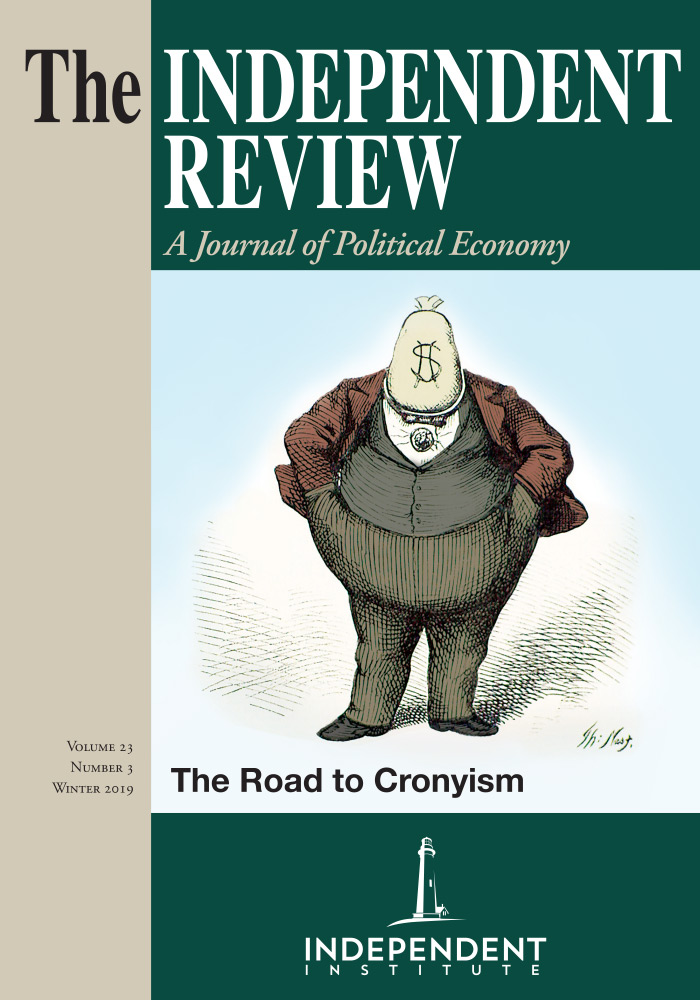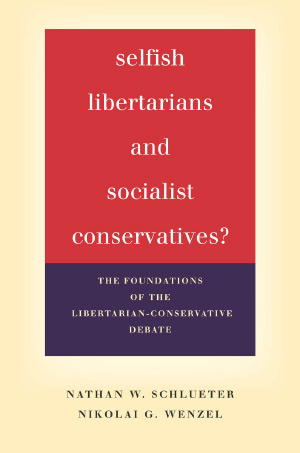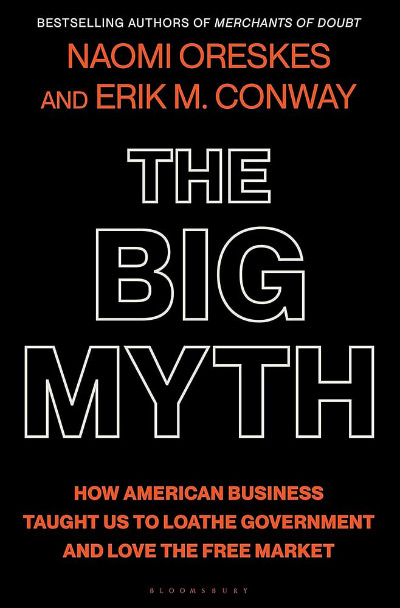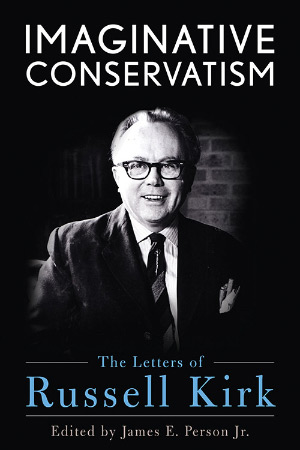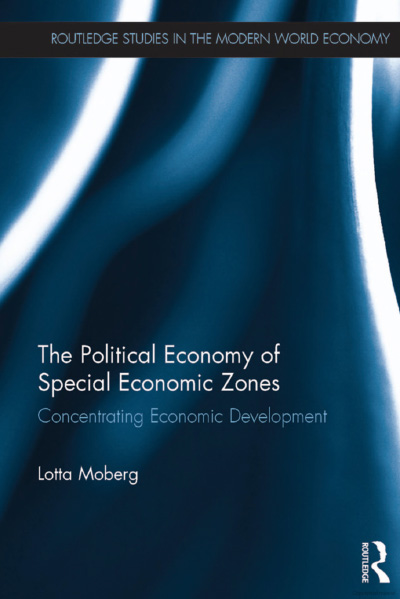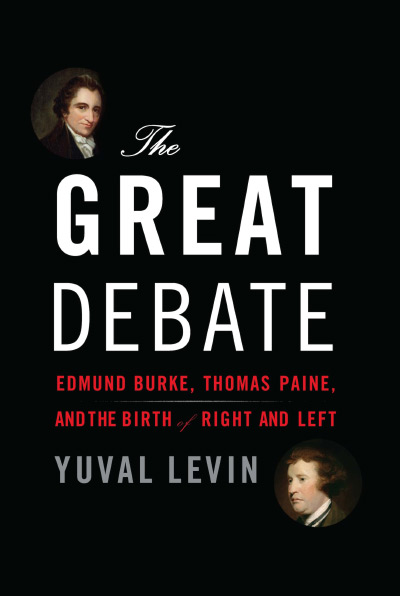Selfish Libertarians and Socialist Conservatives? provides a useful and timely account of fundamental differences between libertarians and conservatives. It is written by two personal friends who affably disagree on a variety of policy questions. As highlighted in the introduction, the book is among the first in which a libertarian and a conservative speak directly to each other. Every two chapters are complementary, with Nathan Schlueter and Nikolai Wenzel offering their own initial arguments, rebuttals, case studies, and conclusions. Although the reader might at times desire more information about the topics the authors address, each author is meticulous in providing relevant citations and additional, recommended readings. Given the book’s brevity, the authors can be applauded for its scope.
In chapter 1, Schlueter argues that American conservatism “rests on a recognition of the natural interdependence of liberty, tradition, and reason” or an “equilibrium of liberty” (p. 14). To him, the American founding achieved just such a balance. Borrowing from the work of John Finnis (Natural Law and Natural Rights [Oxford: Oxford University Press, 2011]), Schlueter uses the phrase “natural law liberalism” interchangeably with the term conservatism. Such a unified conservatism is said to combine principles from libertarianism, traditionalism, and neoconservatism, which respectively value liberty, tradition, and reason most highly. Hence, conservatism seeks to preserve the balance of values achieved by the American founding. This balance includes limits on government power, recognition of people’s natural rights, and the consent (to govern) by citizens who have “restraint, toleration, trust, intellectual development, and respect for the rule of law” (p. 37). These facets form natural law liberalism, which is a “form of classical liberalism . . . [that accounts] for the complex realities of social and political life” (p. 38). For Schlueter, the “equilibrium of liberty must be grounded in moral character and provided for in political institutions” (p. 43).
Although Wenzel might respect a rights-based justification for liberty, he employs the “simpler approach of robust political economy: People are not omniscient and cannot be assumed to be benevolent” (p. 47). Given these assumptions,Wenzel argues in chapter 2 that we all should instead ask which institutions can cope with human limitations. Conservatives might have many valid concerns, but the power they would grant to governments can be abused by self-interested incumbents. Wenzel adopts the view of the minarchist libertarian who empowers government more than the anarchocapitalists would prefer but not quite to the same level as classical liberal ideals. For Wenzel, rights are essential, but they are not necessarily natural. His view is justified in part by the arguments made by public-choice economists, who blame state bureaucracies and rentseeking interests for inefficient collective (i.e., public) outcomes. Wenzel uses the knowledge problem and potential for unintended consequences to argue in favor of minarchy, a term he uses synonymously with libertarianism. Although civil society and personal virtue are important to him, he believes that public policy should not depend on or attempt to reinforce such private decisions of personal association.
Upon making the case for his perspective, each author outlines in chapters 3 and 4 all that is “wrong” with the other perspective. These two chapters seem to reveal a great deal about each author’s argumentative style and academic discipline. Wenzel’s critique is more biting at times. He expresses serious reservations with the idea that morality (or natural law) can be objectively discovered and modified over time and thinks that Schlueter’s “natural law liberalism” is a “fuzzy and amorphous concept” (p. 85). Hence, Wenzel uses the arguments of public-choice theory to suggest that any state enforcement of moral codes has the potential to be abused. Schlueter’s rebuttal is more reserved in tone but no less critical in substance. Schlueter reminds his readers that political life cannot be interpreted merely in economic terms and that noneconomic (e.g., civic) motivations might help to explain political behavior or other decisions. Indeed, in quoting a reflective essay written by Geoffrey Brennan and James Buchanan, Schlueter argues that political life might be impossible without any “romance” at all (pp. 103–4).
Schlueter shows that F. A. Hayek, whom Wenzel cites frequently, advocated conservative policies instead of libertarian ones. Moreover, libertarianism requires a positive moral foundation, and so questioning whether one can attain moral knowledge undermines both libertarianism and conservatism (p. 115).
The book also includes two chapters in which both authors present conservative and libertarian views, which they call “case studies,” on immigration, education, and marriage policies (or nonpolicies). These chapters are helpful for illustrating the substantive implications of their conflicting perspectives. This illustration is especially useful to the reader because policy conflicts are not obviously implied by the arguments presented in the first two substantive chapters. At times, for example, it seems that Wenzel is arguing against central economic planning (which Schlueter would certainly condemn) more so than against tenets of American conservatism. Moreover, both authors outline a variety of shared opinions in the book’s introduction, including opposition to both the “administrative state” and “crony capitalism” (p. 7). The case studies help to remind the reader that substantive policy disagreements still exist between conservatives and libertarians, despite there being many shared opinions. Whereas Schlueter would allow for more state intervention in the three policy areas discussed (including, for example, state funding of civic education and the illegalization of polygamy), Wenzel’s rights-based paradigm is skeptical. Although it is easy to see how the authors disagree with each other on the issues of education and marriage, the implications of their views on immigration are less straightforward. These two chapters might prove of great interest to those wishing to understand more fully the current debates within the Republican Party.
Schlueter’s unified definition of American conservatism is innovative but at times unclear. Other authors have avoided single definitions. For example, George Nash expressed reservations over definitions after tracing the emergence of the conservative movement to a coalescence of three different camps: libertarians, traditionalists, and anti- Communists (The Conservative Intellectual Movement in America since 1945 [Wilmington, Del.: Intercollegiate Studies Institute, 2006]). Although Schlueter recognizes how Nash’s work influenced his definition of conservatism, the neoconservatives’ contribution is unclear in his account. In chapters 1 and 2, both Schlueter and Wenzel could have argued at greater length why their specific definitions of conservatism and libertarianism should be adopted by more individuals who identify as conservatives or libertarians.
Schlueter and Wenzel’s book is comprehensive, but it does not explore means for fusing libertarianism and conservatism. The authors initially dismiss Frank Meyer’s fusionism (see In Defense of Freedom and Related Essays [Indianapolis, Ind.: Liberty Fund, 1996]) and Charles Cook’s “conservatarianism” (see The Conservatarian Manifesto [New York: Crown Forum, 2015]) as unsuccessful attempts at fusing the two paradigms (p. 2). Nash and Meyer were writing during a time when conservatives and libertarians could easily align in opposition to a shared enemy (the Soviet Union). Schlueter and Wenzel might have suggested that the dissolution of Communist states and the rise of populist movements helped to affirm again the policy differences between conservatives and libertarians. Their book also does not include a detailed summary of what ideas both libertarianism and conservatism might oppose. The introduction includes a listing of some ideas that both authors object to, but it is unclear who (other than John Rawls) formulated those ideas. Examining (and perhaps refuting) attempts to fuse libertarianismand conservatism, as well as examining what makes these perspectives different from progressivism, might have made for a unified (i.e., two-author), albeit lengthy, conclusion in place of the two separate conclusions given.
In the end, perhaps the biggest difference between the libertarian Wenzel and the conservative Schlueter is the degree to which they recognize the importance of Edmund Burke’s “pleasing illusions” or “prejudices” (see Reflections on the Revolution in France [Indianapolis, Ind.: Hackett, 1987]). Both Wenzel and Schlueter claim to represent versions of classical liberalism, and neither one denies the importance of personal liberty or the allocative efficiency of markets. However, it is Schlueter’s traditionalistic elements of conservatism that Wenzel objects to the most vigorously. Like Burke, Schlueter argues that traditions can help to influence political behavior in ways independent of self-interest. Unlike Burke, Wenzel suggests that the actions of voters and state actors, given self-interest, might be predictable. Each author balances the relative roles of tradition and reason (in influencing human behavior) differently when prescribing ideal public policies.
There are many reasons to laud (and read!) Schlueter and Wenzel’s book. The authors provide a comprehensive but succinct summation of the libertarian– conservative debate. Although other descriptions of libertarian and conservative views exist (see especially George Carey, ed., Freedom and Virtue: The Conservative/Libertarian Debate [Wilmington, Del.: Intercollegiate Studies Institute, 2004]), as well as some instances where scholars of both camps respond to current events (see, e.g., Constitutional Commentary 26, no. 2 [2010], for a symposium of libertarian and conservative responses to the Obama administration), Selfish Libertarians and Socialist Conservatives? is the first book in which two members of these camps respond directly to each other in turn to illuminate the “foundational arguments” (p. 3) of their perspectives. The book should be lauded for its breadth. In only two hundred pages, it explores a variety of perspectives within both libertarianism and conservatism. If one is looking for a primer on the differences between these two perspectives, then one would be hard-pressed to find a shorter yet more comprehensive and elegant work. With its many citations, this book should be a starting point for any conservative or libertarian wishing to explore, understand, and defend his or her perspective.

